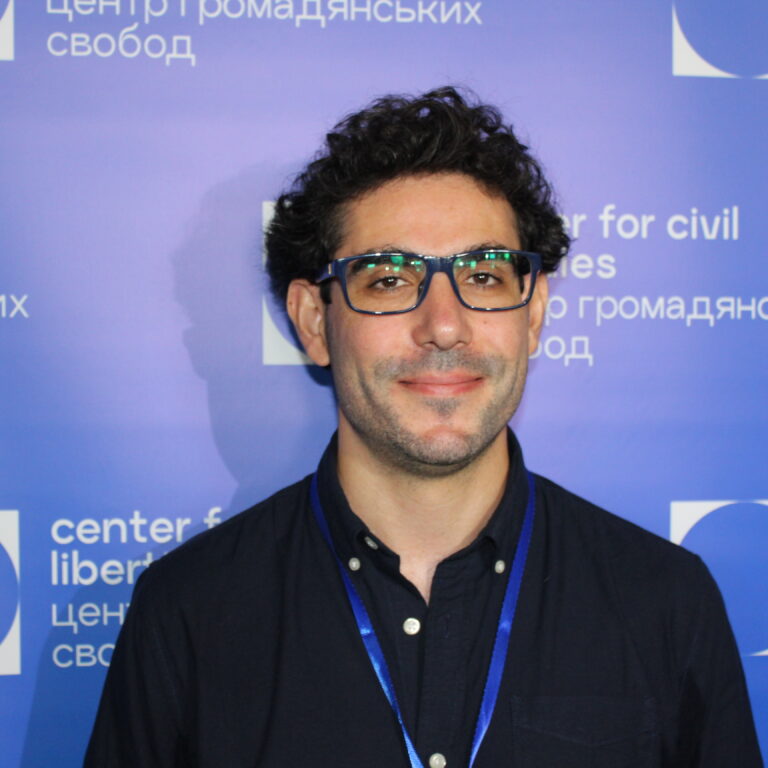Our Association monitors with particular attention the international proceedings leading to the aggressor’s payment of reparations for the harm caused to Ukraine and its population. Thanks to a public hearing arranged by the Parliamentary Assembly of the Council of Europe (PACE), we were able to glimpse behind the scenes of European diplomacy on Monday.
From a nearly one-and-a-half-hour chat [1], ARC’s expert for international judiciary Oleksiy Plotnikov selected the most significant points. Therefore, this material describes how Ukraine and Council of Europe specialists view the reparations procedure.
Principal speaker at the event was Deputy Minister of Justice of Ukraine Iryna Mudra, who specializes in state policy in the area of confiscation of assets of persons subject to sanctions, including taking measures to identify and search for assets of individuals and legal entities specified in the relevant decisions of the Council of National Security and Defense of Ukraine [2], so her competence in the issue of reparations from Russia is beyond question.
Ms. Mudra outlined the Ukrainian suggestions for the establishment of an international register of damages caused by Russian aggression, as well as a Compensation fund and Compensation commission. Professor Burkhard Hess, head of the Max Planck Institute Luxembourg for International, European and Regulatory Procedural Law in Luxembourg, was the second keynote speaker. He supplied his expert opinion on reparation-related legal difficulties and their potential resolutions.
It is important to note that such PACE sessions have a solely practical purpose. On the basis of the findings presented at previous sessions, the PACE issued a resolution calling for the establishment of a tribunal to prosecute the Russian leadership for the crime of aggression [3]. It is anticipated that the PACE will consider the report based on the results of the current hearings as early as January 2023 [3], so there is reason to believe that this review may conclude with the adoption of a resolution that could formalize the beginning of the process of establishing a reparations mechanism within the PACE.
The Ukrainian perspective on the reparations procedure may be summed up as follows. Since Russian aggression has already caused unspeakable human suffering and destruction in Ukraine, it is necessary to hold the aggressor accountable and design an innovative compensation structure that would collect monies from the aggressor to pay victims compensation and reconstruct what was destroyed. This mechanism will be based on a multilateral international agreement and will include a Compensation Commission and a Compensation Fund. The Commission will be responsible for evaluating requests for compensation, and the Compensation Fund should ensure that the Commission’s recommendations are effectively implemented.
Clearly, the procedure of finalizing a relevant agreement cannot be quick. To expedite the process, the deputy minister proposed initiating a technical bilateral agreement between the Ukraine and the state where the Compensation Mechanism will be registered. Such an agreement will make it possible for the Mechanism to be located outside of Ukraine, allowing it to be independent and impartial, while also being quite straightforward to reach. In the future, once all technical details have been resolved, the agreement will be available for signature by other states. The negotiations on participation will prioritize members of the Council of Europe and the Big Seven, where the lion’s shares of Russian governmental and private assets are located.
The Commission and the Fund shall utilize the Register of Damages, which is suggested to be established by the Resolution of the General Assembly of the United Nations of 14 November 2022 and ARC has written on this previously. This register should become an integral part of the compensation mechanism and contain evidence of claims for compensation for suffering and damages caused by aggression and other illegal actions of Russia to all affected persons and legal entities, as well as to the Ukrainian state as a whole.
The Register will comprise information on claims for compensation and evidence for their justification, split into categories, as well as information required for evaluating admissibility based on territorial and temporal criteria, as well as the damage caused criterion. It is proposed that this registry take the form of a digital platform that can be utilized to submit claims for compensation and supporting documentation. This platform should automate as much as practicable the process of entering data, authenticating the identity of applicants, and providing evidence, as well as data on the location, time, and nature of the damage.
The construction of a legislative framework for the confiscation of Russian assets should be an essential prerequisite for commencing the process of recovering damages and compensation, and ARC previously wrote about the legal aspects of this process in various jurisdictions. Therefore, the representative of Ukraine urged PACE member states to continue seizing Russian property and freezing assets until a legal resolution about their confiscation and transfer to the Compensation Fund can be reached.
Professor Burkhard Hess, who regularly advises the European Commission, the European Parliament, the Council of Europe and national governments on issues of commercial law and regulation, presented a report on practical legal issues and possible mechanisms for seizing Russian assets and property in order to replenish the Compensation Fund for Ukraine at their expense.
Professor Hess pointed that the Russian Federation bears international legal responsibility for aggressive war and countless violations of international law committed against Ukraine, its residents, and nationals of other states as well as Ukrainian and foreign legal entities. Such violations are considered to be against the world community as a whole.
Consequently, all states may employ remedies against the violator, including confiscation of property. The subject of confiscation should be funds and assets with a total worth of 660 billion dollars, including assets of the Central Bank of the Russian Federation situated abroad, Russian state property abroad and property of Russian state corporations such as Gazprom, and private funds and assets, owned by Russian oligarchs.
Legal foundations for establishing a reparations mechanism can be established by decisions of the United Nations General Assembly and agreements between interested states. The “Kuwait model” of compensations, which the ARC wrote about previously, may be inapplicable in this case because it was developed on the basis of a UN Security Council resolution, which is practically unachievable for Ukraine so long as Russia keeps the “permanent seat” on the Security Council. Under such circumstances, it would be desirable to develop a system through an agreement between states, the political and legal justification for which might be the General Assembly’s resolution [5].
According to the speaker, the most troublesome issue that needs to be resolved is the sovereign immunity of state property, specifically funds in foreign state bank accounts. A feasible option, based on past practice, could be to separate the bank’s own money from those that have been invested, or utilized for commercial reasons. Utilizing public funds for financial advantage overseas diminishes their level of protection. Such funds include, for instance, the Russia’s “National welfare fund”, which is invested in foreign financial assets and used for profit.
The second potential source is the seizing of the funds of Russian oligarchs. Such confiscation is permissible based on the rulings of national courts in the context of criminal proceedings. In circumstances involving the circumvention of sanctions imposed on the aggressor, criminal actions may be an alternative. The decision of the EU Council to recognize the circumvention of sanctions as a criminal act in the European Union creates a basis for such proceedings. According to the relevant instrument, EU member states should amend their respective criminal legislation [6]. In addition, according to Professor Hess, the riches of Russian oligarchs can be viewed as having been acquired through illegal means, and as a result, their protection against confiscation is lower than if they had been acquired through lawful means.
The third source of funds for the Compensation Fund is Russian money and assets used as part of bilateral investment treaties with European states. Such funds and assets usually do not benefit from state immunity.
In the discussion that followed the presentation of the reports, it should be emphasized whether the prospective mechanism of reparations may be used to implement the rulings of international courts on Ukraine’s and individual citizens’ claims against the aggressor state.
Such cases include those heard by the International Court of Justice of the United Nations that pertain to occupiers’ racial discrimination in the Crimea, as well as Russia’s support of terrorism in Donetsk and Luhansk oblasts, and exploitation by Russia of the notion of genocide to legitimize aggression.
Several interstate complaints of Ukraine against Russia are pending before the European Court of Human Rights, including those connected to human rights breaches during the occupation of the Crimea.
Those present were optimistic about the likelihood of reimbursement for such claims through the Compensation Mechanism. Thus, according to Professor Hess, the evidence of human rights breaches gathered within the context of such processes might serve as a solid foundation for completing the damage register.
Moreover, international court judgements serve as proof of violations of international law in general. It is not just about an aggressive war, but also about the full spectrum of breaches committed by the Russian Federation against Ukraine, its citizens and legal entities, and possibly also against citizens and legal entities of other states. As for the precise procedure of recovery, international court decisions can serve as evidence that the money and assets subject to seizure were obtained illegally, so facilitating their transfer to the Compensation Fund.
We must add that the decision taken by the United Nations General Assembly on November 14 about the formation of a mechanism of reparations from the aggressor to Ukraine [7] made it possible to consider the execution of such a mechanism. Due to Russia’s “veto power” in the Security Council, the United Nations has difficulty with this, but other international bodies do not. The PACE appears to be the most attractive platform for the formation of such a mechanism, which was the topic of debate at the hearing. The expert opinions voiced during them will serve as the basis for the PACE’s decisions and as justification for the mechanism’s functioning in individual states.
From the very beginning, PACE considers the broadest possible approach to the sources of reparations, including the property of the Russian state, state-owned enterprises, and individual citizens, such as oligarchs, associated with the Russian terrorist regime. There are some normative issues to collecting reparations, but they can be overcome via proper legal mechanisms. So the question is no longer whether the Compensation Mechanism will be created. The only question is how to make it as effective as possible.
- https://www.youtube.com/watch?v=v5K1yR2czV4
- https://minjust.gov.ua/people/iryna-mudra
- https://pace.coe.int/en/news/8699
- https://pace.coe.int/en/news/8918/compensation-mechanisms-for-ukraine-the-focus-of-a-pace-hearing-in-paris
- https://press.un.org/en/2022/ga12470.doc.htm
- https://data.consilium.europa.eu/doc/document/ST-10287-2022-REV-1/en/pdf
- https://news.un.org/en/story/2022/11/1130587







